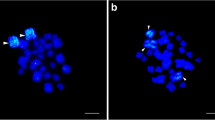Abstract
The primitive termite Kalotermes approximatus carries a number of reciprocal translocations (segmental interchanges) that are linked to the sex-determining mechanism in such a way that males are permanent structural heterozygotes, forming long chains or rings of chromosomes in meiosis, while females are structural homozygotes, forming only bivalents. A survey of male meiosis from collections covering nearly the whole species range in the southeastern United States reveals considerable variation in the number of translocations: males with a diploid number of 32 or 33 have meiotic chains of 11, 13, 14, 15, 16, and 17 or 19 chromosomes. The different types can be arranged in an evolutionary series of rearrangements involving translocations or Robertsonian fusions between chromosomal elements in the ring and those outside. In addition, the existence of a closed chain (ring) of 16, and of four different types of chain of 13, indicate that similar rearrangements have occurred among chain elements. The geographic pattern of these rearrangements suggests that their selection accompanied the expansion of the species northward from southern Florida sometime since the last glaciation or, alternatively, that as they arose the new translocation types successively supplanted the ancestral types, preferentially in the east-central portion of the range.
Similar content being viewed by others
References
Barlow, B.A., Wiens, D., Wiens, C., Busby, W.H., Brighton, C.: Permanent translocation heterozygosity in Viscum album and V. cruciatum: sex association, balanced lethals, sex ratios. Heredity 40, 33–38 (1978)
Chinnappa, C.C., Victor, R.: Achiasmatic meiosis and complex heterozygosity in female cyclopoid copepods (Copepoda, Crustacea). Chromosoma (Berl.) 71, 227–236 (1979)
Clausen, C.J., Cohen, A.D., Emiliani, C., Holman, J.A., Stipp, J.J.: Little Salt Spring, Florida: a unique underwater site. Science 203, 609–614 (1979)
Cleland, R.E.: Oenothera, cytogenetics and evolution. New York. London: Academic Press 1972
Craddock, E.M.: Intraspecific karyotypic differentiation in the Australian phasmatid Didymuria violescens (Leach). I. The chromosome races and their structural and evolutionary relationships. Chromosoma (Berl.) 53, 1–24 (1975)
Darlington, C.D., LaCour, L.F.: Hybridity selection in Campanula. Heredity 4, 217–248 (1950)
Imai, H.T., Crozier, R.H., Taylor, R.W.: Karyotype evolution in Australian ants. Chromosoma (Berl.) 59, 341–393 (1977)
James, S.H.: Complex hybridity in Isotoma petraea. I. The occurrence of interchange heterozygosity, autogamy and a balanced lethal system. Heredity 20, 341–353 (1965)
John, B., Quraishi, H.B.: Studies on Periplaneta americana. IV. Pakistani populations. Heredity 19, 147–156 (1964)
Luykx, P., Syren, R.M.: The cytogenetics of Incisitermes schwarzi and other Florida termites. Sociobiology 4, 191–209 (1979)
Martin, P.G., Hayman, D.L.: A complex sex-chromosome system in the hare-wallaby Lagorchestes conspicillatus Gould. Chromosoma (Berl.) 19, 159–175 (1966)
Matthey, R.: Un type nouveau de chromosomes sexuels multiples chez une souris africaine du groupe Mus (Leggada) minutoides (Mammalia-Rodentia). Male: X1X2/Y, Femelle: X1X2/X1X2. Chromosoma (Berl.) 16, 351–364 (1965)
Ogawa, K.: Chromosome studies in the Myriapoda. VII. A chain-association of the multiple sex chromosomes found in Otocryptops sexspinosus (Say). Cytologia (Tokyo) 19, 265–272 (1954)
Ogawa, K.: Chromosome studies in the Myriapoda. XIII. Three types of the sex-chromosomes found in Otocryptops rubiginosus (L. Koch). Jap. J. Genet. 36, 122–128 (1961a)
Ogawa, K.: Chromosome studies in the Myriapoda. XV. On individually different three karyotypes found in Otocryptops (Chilopoda) (Preliminary report). Zool. Magazine (Tokyo) 70, 178–179 (1961b)
Smith, S.G.: Chromosomal polymorphism in North American Pissodes weevils: structural isomerism. Canad. J. Genet. Cytol. 12, 506–540 (1970)
Syren, R.M., Luykx, P.: Permanent segmental interchange complex in the termite Incisitermes schwarzi. Nature (Lond.) 266, 167–168 (1977)
Vincke, P.P., Tilquin, J.P.: A sex-linked ring quadrivalent in Termitidae (Isoptera). Chromosoma (Berl.) 67, 151–156 (1978)
Watts, W.A.: Postglacial and interglacial vegetation history of southern Georgia and central Florida. Ecology 52, 676–690 (1971)
Weesner, P.M.: Termites of the nearctic region. Biology of termites (K. Krishna and F.M. Weesner, eds.), vol. II, pp. 477–525, 1970
White, M.J.D.: Speciation in the Australian morabine grasshoppers — the cytogenetic evidence. In: Genetic mechanisms of speciation in insects, M.J.D. White (ed.), pp. 57–68. Dordecht, Boston: D. Reidel Publ. Co. 1972
White, M.J.D.: Animal cytology and evolution, 3d edit. Cambridge University Press 1973
White, M.J.D.: Blattodea, Mantodea, Isoptera, Grylloblattodea, Phasmatodea, Dermaptera and Embioptera. In: Animal Cytogenetics (B. John, ed.), vol. 3, Insecta 2, pp. 1–75. Berlin, Stuttgart: Gebrüder Borntraeger 1976
White, M.J.D.: Modes of speciation. San Francisco: W.H. Freeman and Co. 1977
White, M.J.D.: Chain processes in chromosomal speciation. Syst. Zool. 27, 285–298 (1978)
White, M.J.D., Blackith, R.E., Blackith, R.M., Cheney, J.: Cytogenetics of the viatica group of morabine grasshoppers. I. The “coastal” species. Aust. J. Zool. 15, 263–302 (1967)
White, M.J.D., Webb, G.C., Cheney, J.: Cytogenetics of the parthenogenetic grasshopper Moraba virgo and its bisexual relatives. I. A new species of the virgo group with a unique sex chromosome mechanism. Chromosoma (Berl.) 40, 199–212 (1973)
Whitehead, D.R.: Studies of full-glacial vegetation and climate in southeastern United States. In: Quaternary Paleoecology (E.J. Cushing and H.E. Wright, Jr., eds.), vol. 7 of the Proc. VII Congr. Intern. Assoc. Quaternary Res., pp. 237–248. New Haven, London: Yale University Press 1967
Author information
Authors and Affiliations
Rights and permissions
About this article
Cite this article
Syren, R.M., Luykx, P. Geographic variation of sex-linked translocation heterozygosity in the termite Kalotermes approximatus snyder (Insecta: Isoptera). Chromosoma 82, 65–88 (1981). https://doi.org/10.1007/BF00285750
Received:
Accepted:
Issue Date:
DOI: https://doi.org/10.1007/BF00285750




